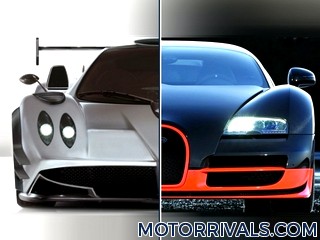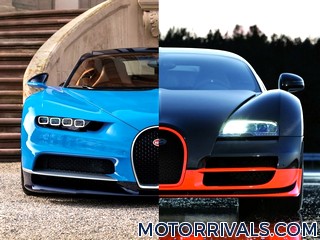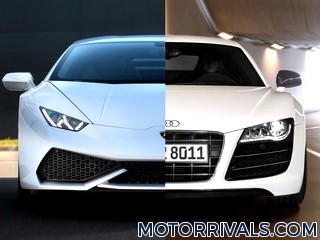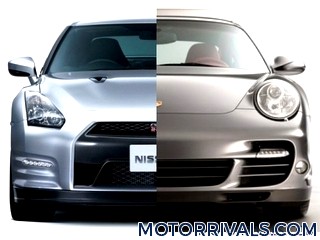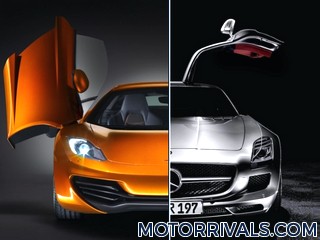2011 Bugatti Veyron Super Sport vs 2010 Pagani Zonda R
The Veyron and Zonda sit on two opposite ends of the spectrum. It would be like comparing the space shuttle to the F-22 Raptor. Each supercar focuses on very different priorities. The Veyron Super Sport's main purpose is speed, and speed it does achieve. Just recently the Veyron Super Sport has managed to break the record for top speed with an unfathomable 268 mph (267.81 mph if you want to be specific). The Zonda R on the other hand, focuses more on all-around ability. It too has broken a record at the infamous Nürburgring with a lap time of 6 minutes and 47 seconds.
Bugatti and Pagani are both sort of one trick companies. They have a variety of different flavors of basically the same vehicle (for now at least). Considering how powerful each model is though, every available resource has been used on these two supercars. Sadly, both the Veyron and Zonda are due to stop production soon and these will be the last iterations. But Bugatti and Pagani aren't just going out with a bang, they're going out with an explosion.
What you essentially have here is a battle of brawn versus brains. The Veyron has long been known as the most almighty powerful vehicle on Earth and has gotten the most attention due to its 1000-plus horsepowe, 16-cylinder, quad-turbocharged engine and record-breaking top speed. The Super Sport goes even further by adding 200 horsepower and dropping over 600 pounds in weight. With a new front fascia to aid in aerodynamics, Bugatti has done everything possible to achieve a top speed second to none.
The Zonda R however, is more than a one trick pony. In essence, it is a race car with performance and looks to match. It obviously shares a visual relationship to the Zonda F but only shares 10% of the components. Pagani says the Zonda R has been built from scratch despite the family resemblance. The F1-style nose is still there but the front fascia has been reworked with more vents, flaps, and air intakes for ultimate aerodynamics and downforce.
The Veyron doesn't look like your typical supercar of the past. If you mention the Veyron to anyone with just a faint interest in cars, they'll go on about the ridiculous amount of horsepower or record-setting top speed but won't really talk about the design. They might not even recognize the differences between the Super Sport and the original Veyron but there are some noticeable ones. The lower front fascia has been redesigned with larger air intakes and new air intake runs the width of the car. The massive wheel arches and vents are all still there though. The Veyron isn't sleek or particularly fast-looking when it's standing still and is built for the road rather than the track like the Zonda R.
Quite frankly, I don't have the intelligence nor the writing ability to even begin to describe the detail or purpose of the Zonda R's bodywork. You would need to be an automotive designer with a rocket science background to understand the intricacies of every line and every curve. What I can tell you though, is that it's fast, purposeful and the closest thing to F1 or Le Mans race cars. The hood has been stretched compared to the previous Zonda F and along with a longer rear end, the Zonda R is now 15.7-inches longer.
The Veyron Super Sport's body has been streamlined compared to before. The rear has been reworked removing the previous Veyron's massive engine scoops and integrating them into the roof. There now sits two exhaust pipes with a wider but shorter design compared to the single square shape like before. The deployable spoiler still remains and also acts as an airbrake that by itself has the same stopping power of an ordinary hatchback.
The Zonda R's F1-design is ever apparent in the F1-style adjustable rear wing and racing-derived diffuser. The centrally-mounted quad exhaust pipes look like a Gatling gun to intimidate anyone that dares to overtake you. And if they do, the Zonda R's exhaust might just spit some fire out to teach them a lesson.
Like the Zonda R's exterior, the interior is focused on racing. What sits in front of you in the Zonda R is a large LCD screen rather than typical gauges that displays all sorts of information such as the amount of downforce the Zonda R is producing at any given moment. Using sensors placed throughout the car, you'll be able to monitor every single component.
The Veyron Super Sport's interior is more civilized with a few creature comforts one might hope for in a 1.9 million dollar car. It should be noted that not just anyone can hop in and hit 268 mph whenever they want. A special key is needed to unlock the top speed setting. Without it, the Veyron is limited to a measly 220 mph. If the car is able to enable the 'top speed' mode, the front air diffusers close, the car lowers itself, and the rear spoiler retracts. And then the car takes flight.
So if you're a million or billionaire and you're fantasy has always been being an astronaut, then the Veyron Super Sport is the closest thing you can get short of going into outer space. But if you've always fantasized about being an F1 driver, then the Zonda R is begging to be piloted.



